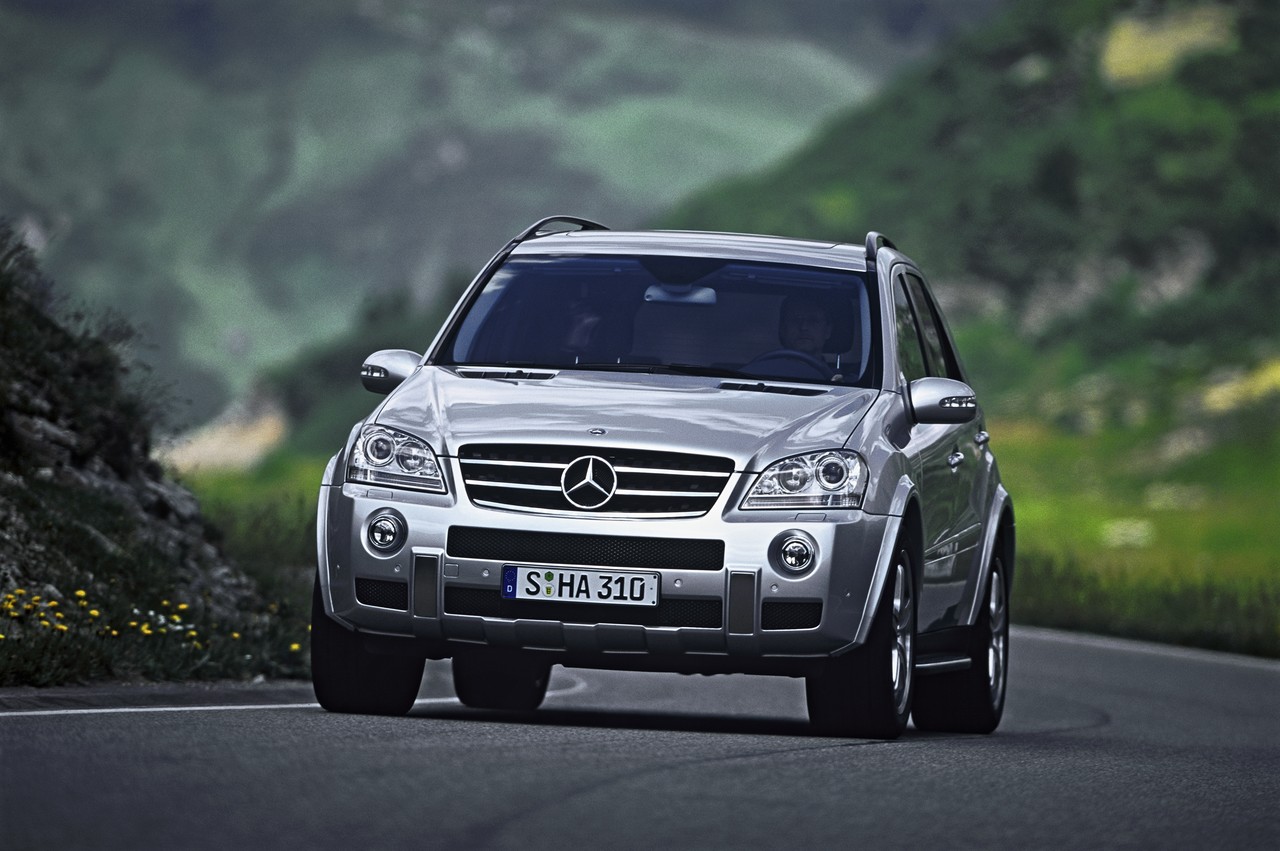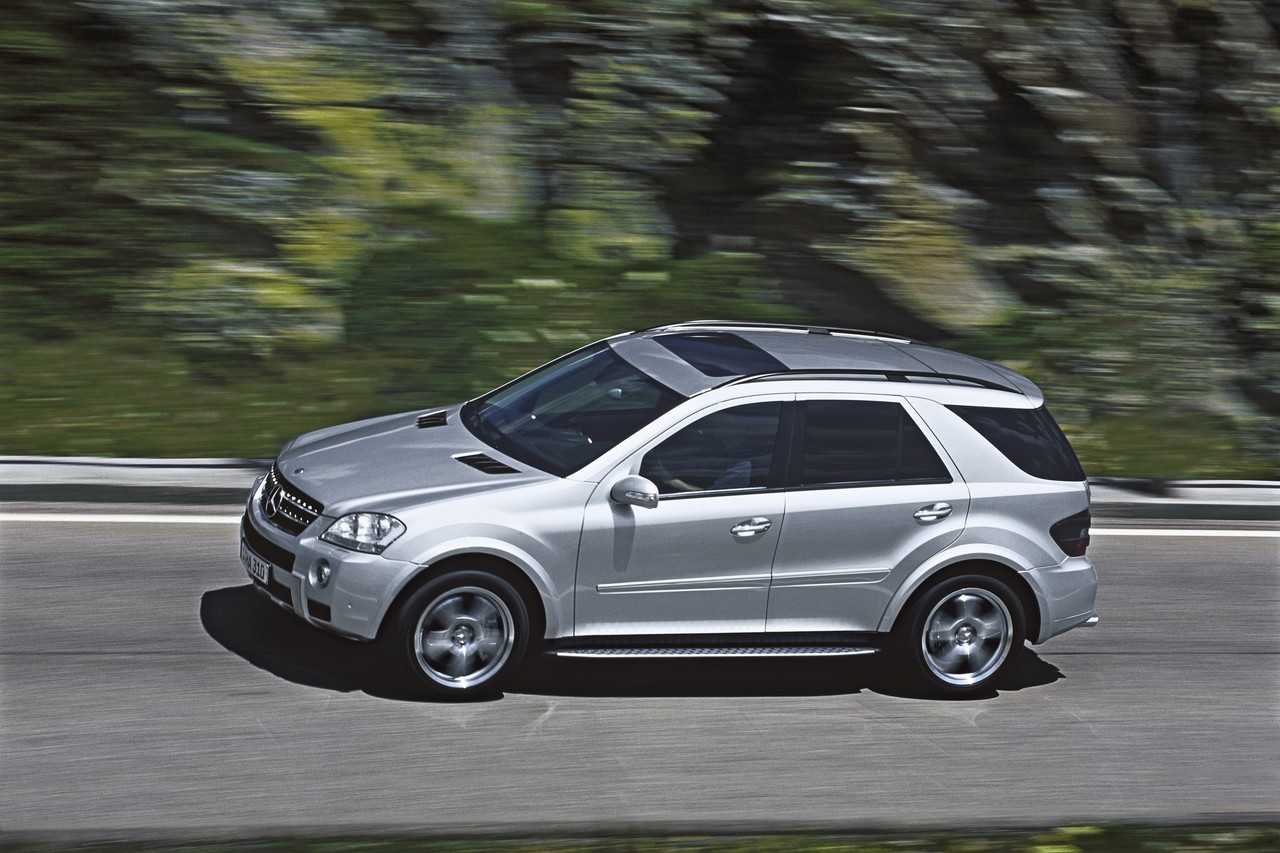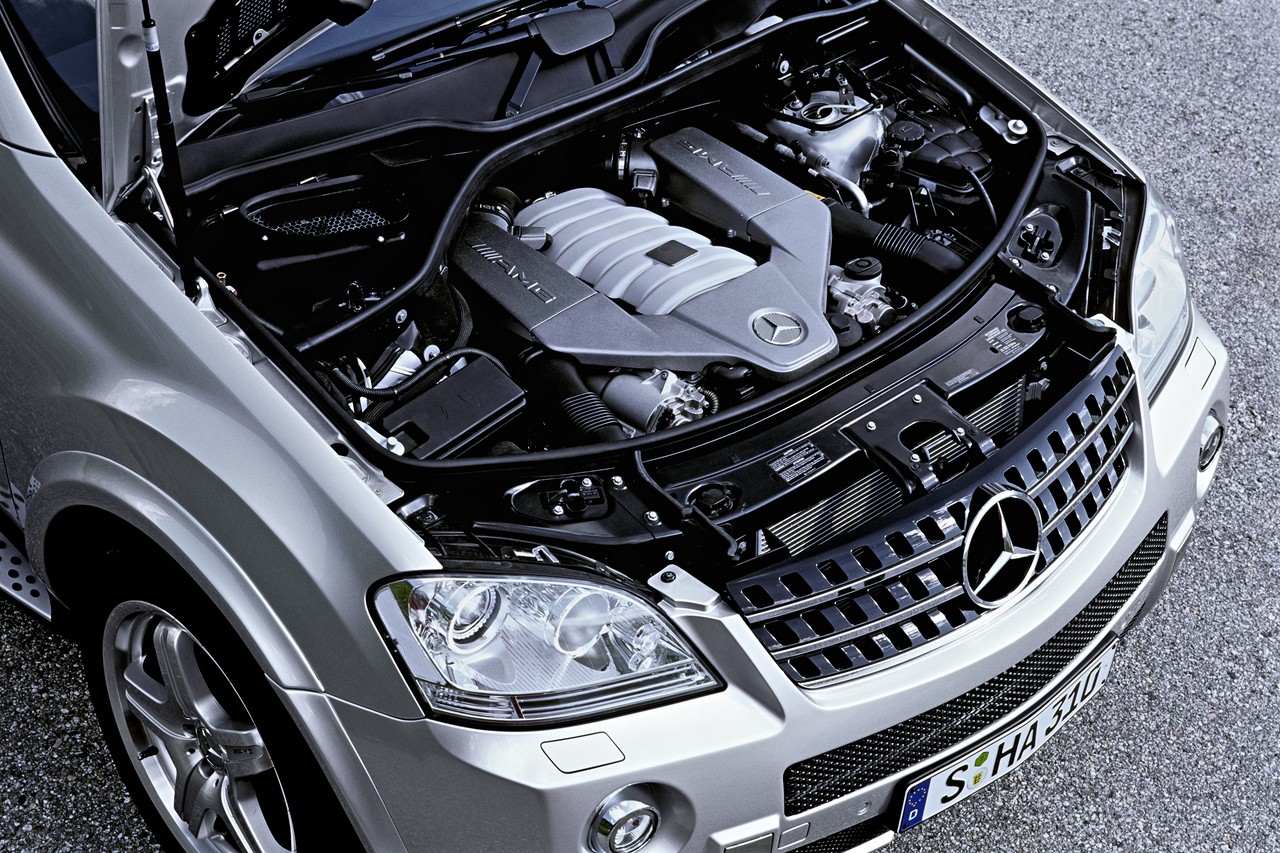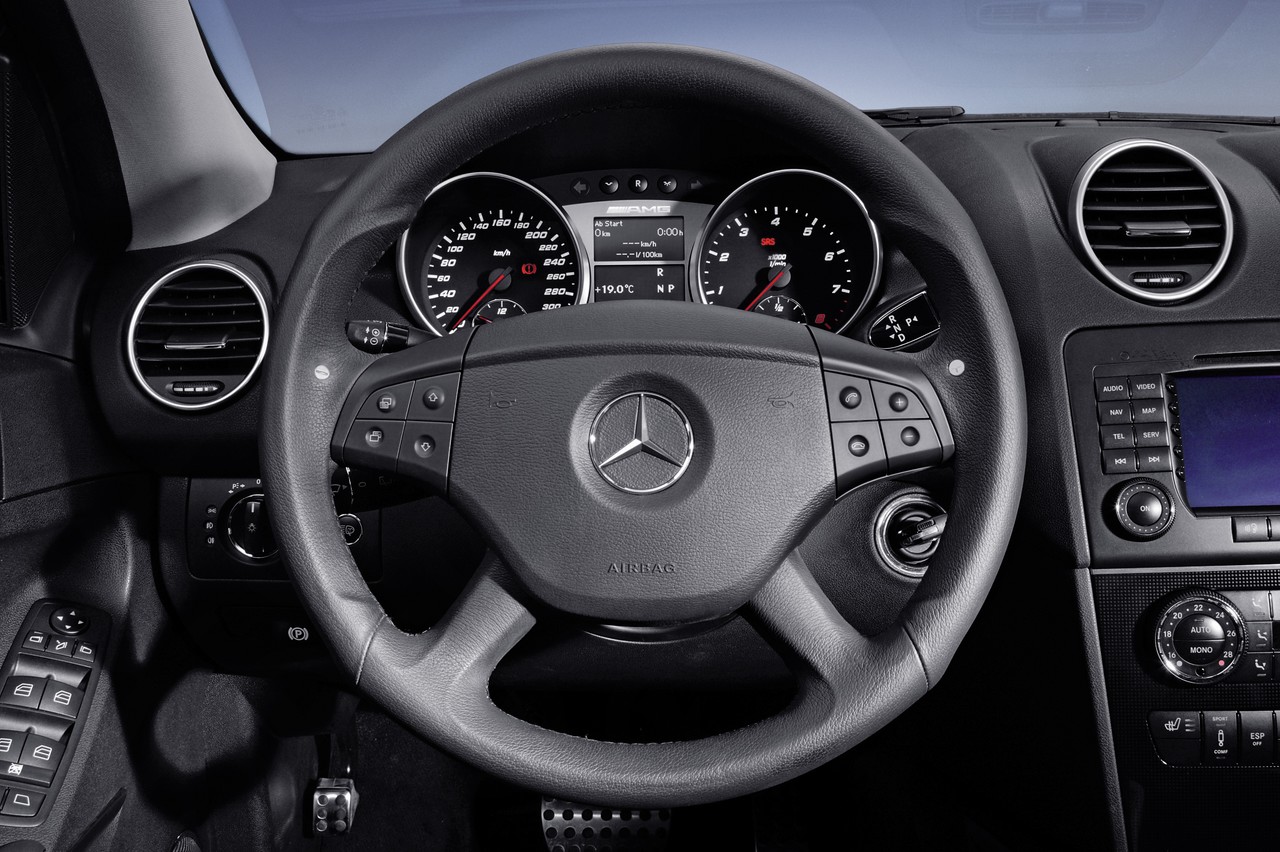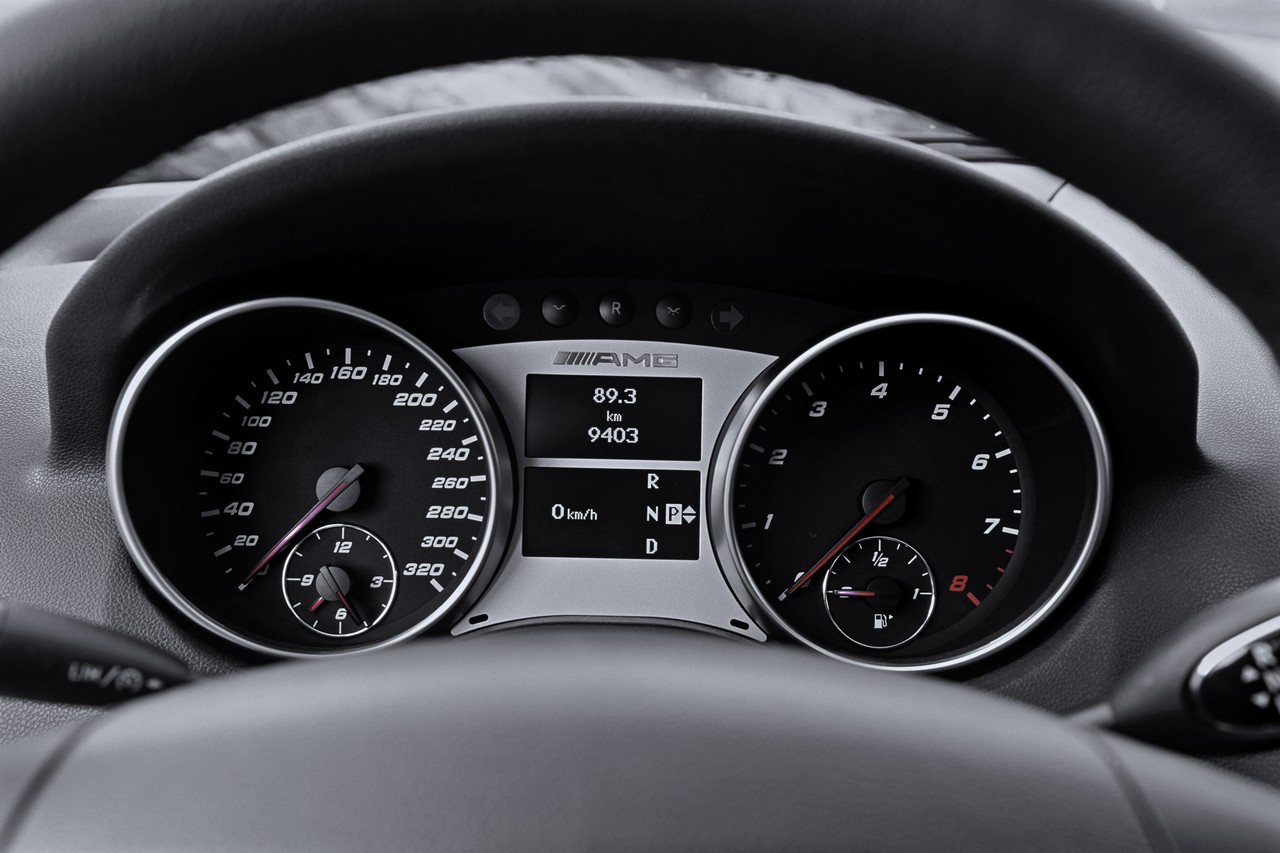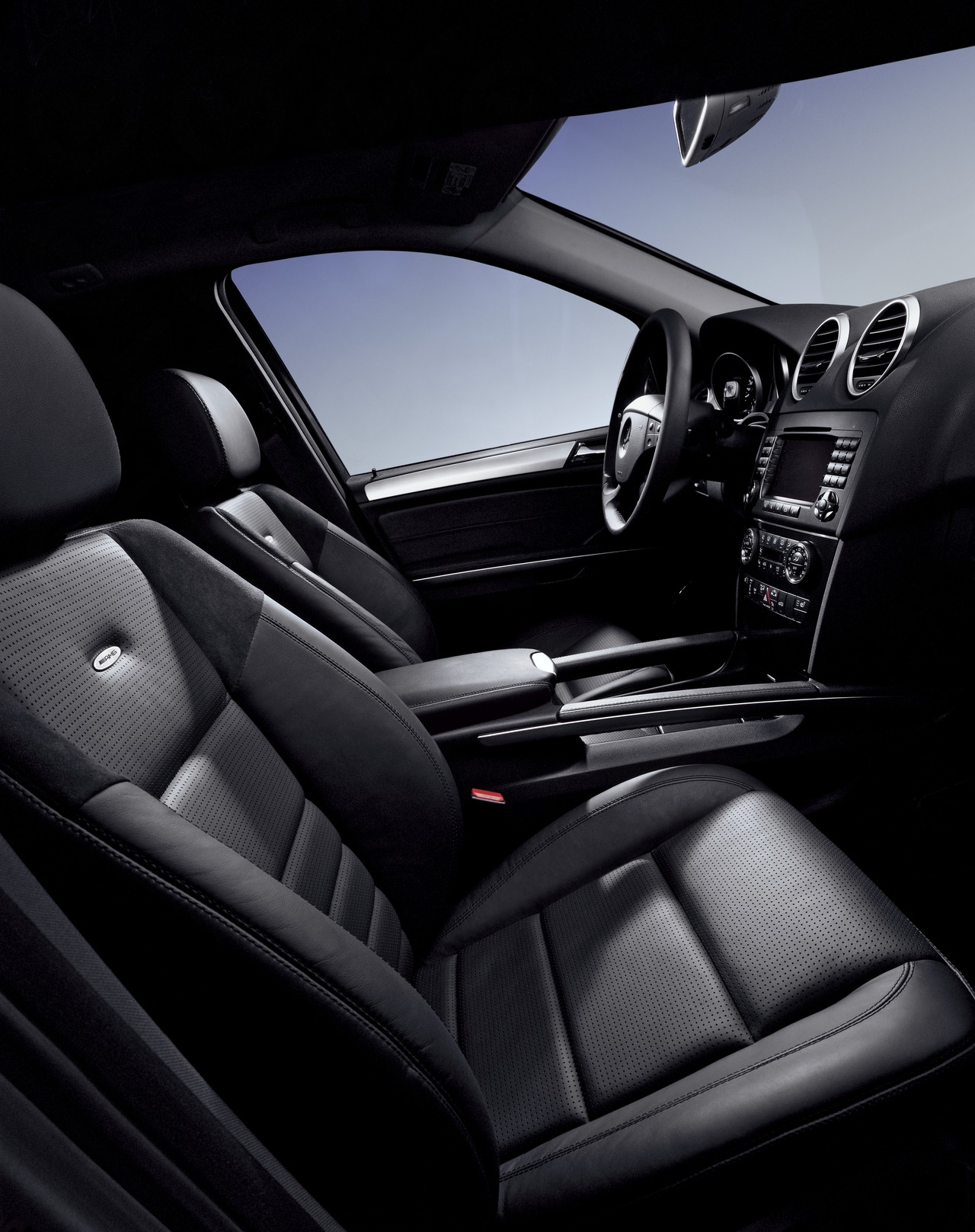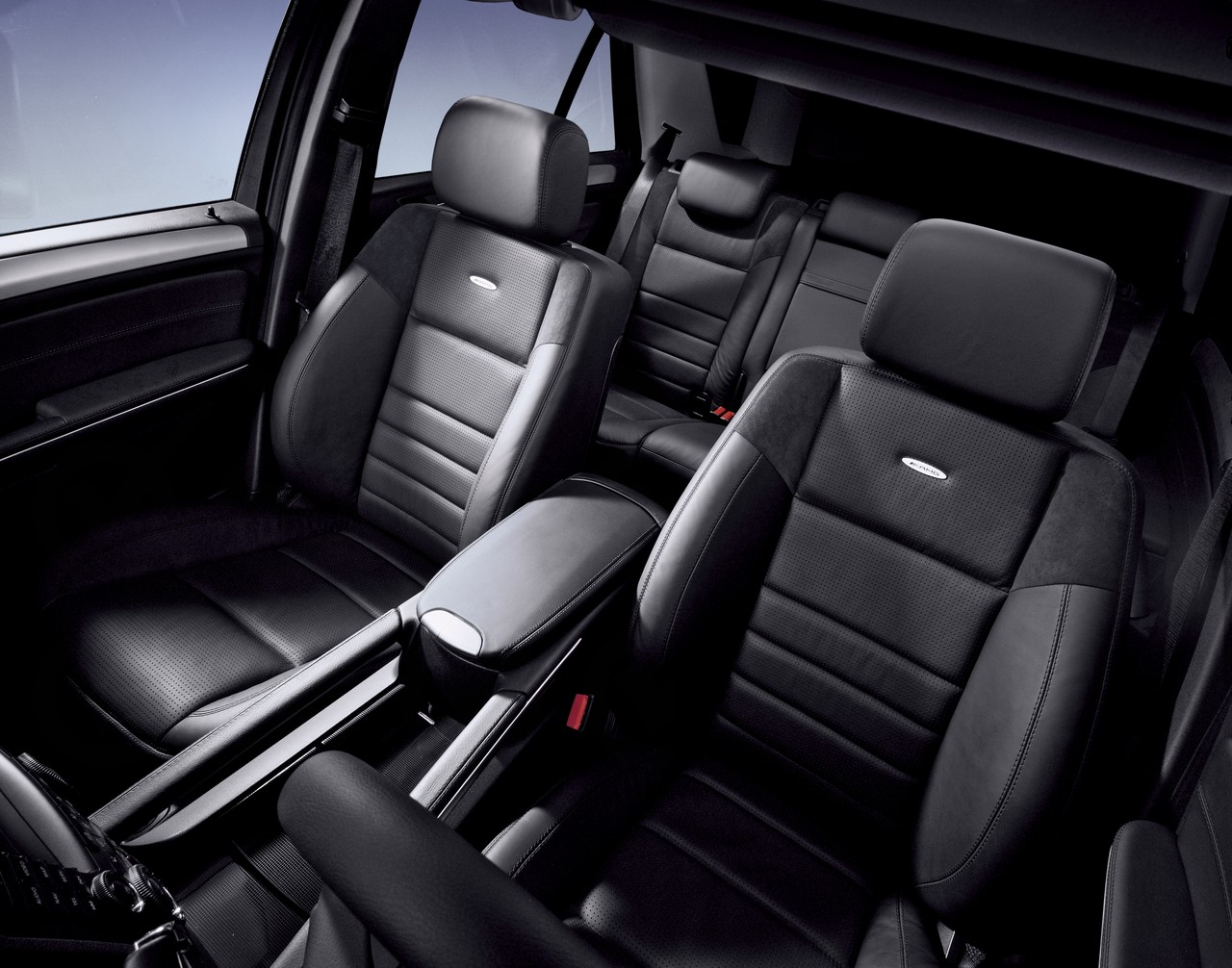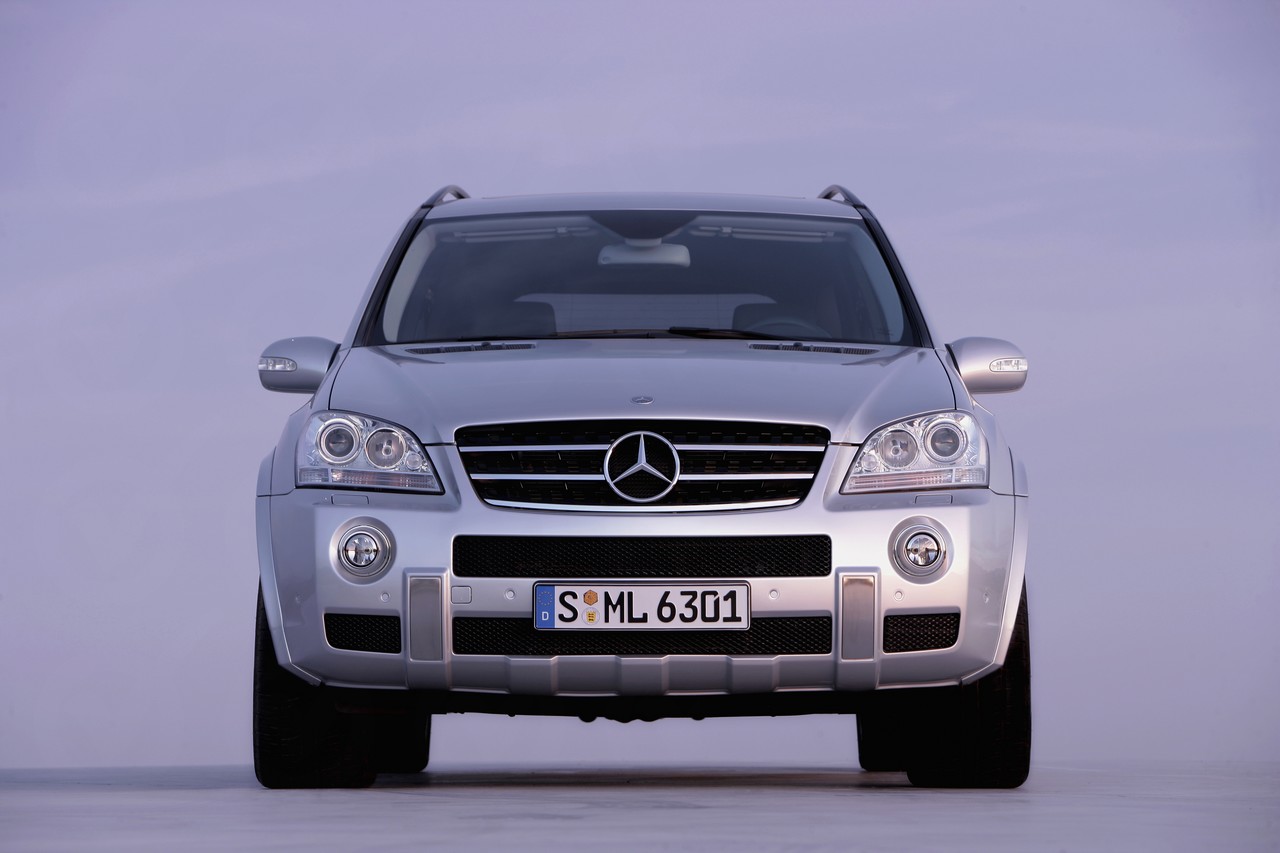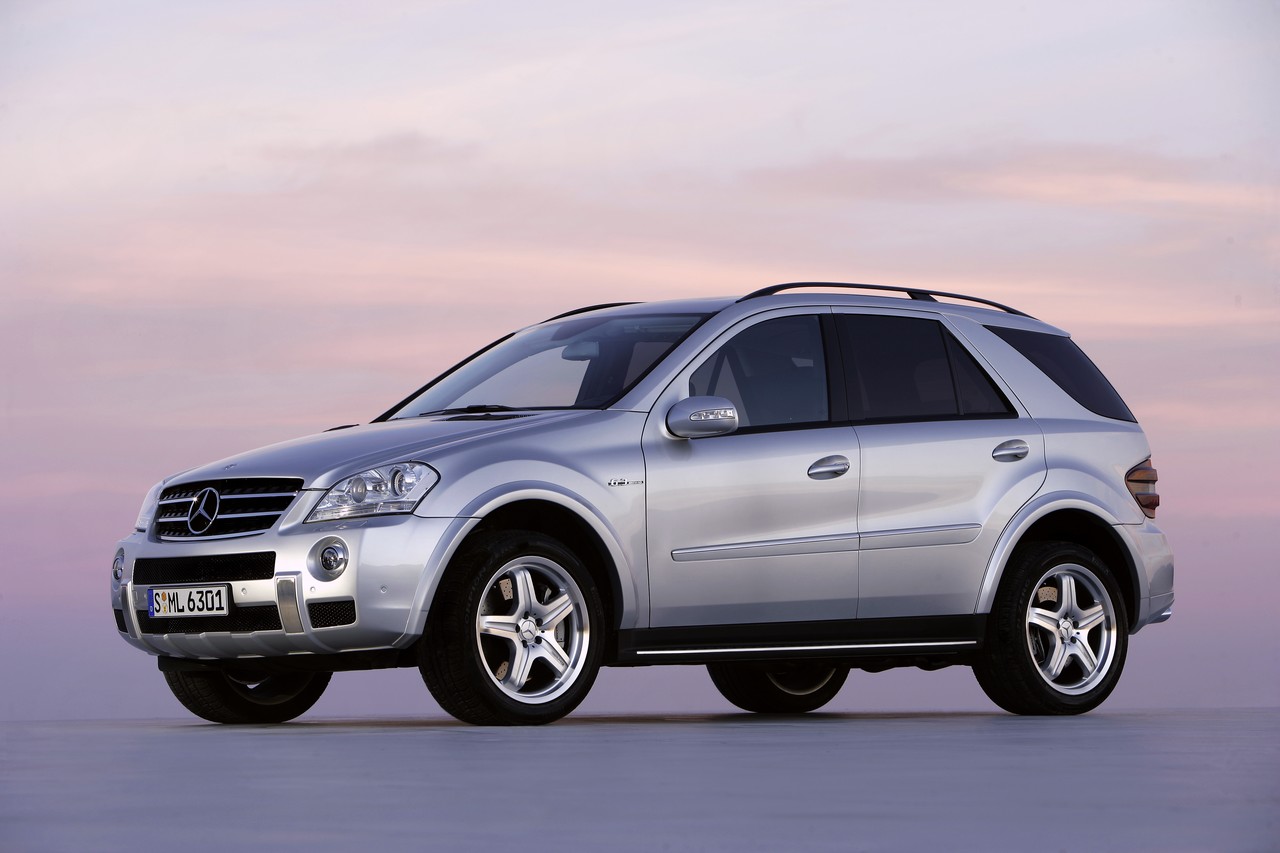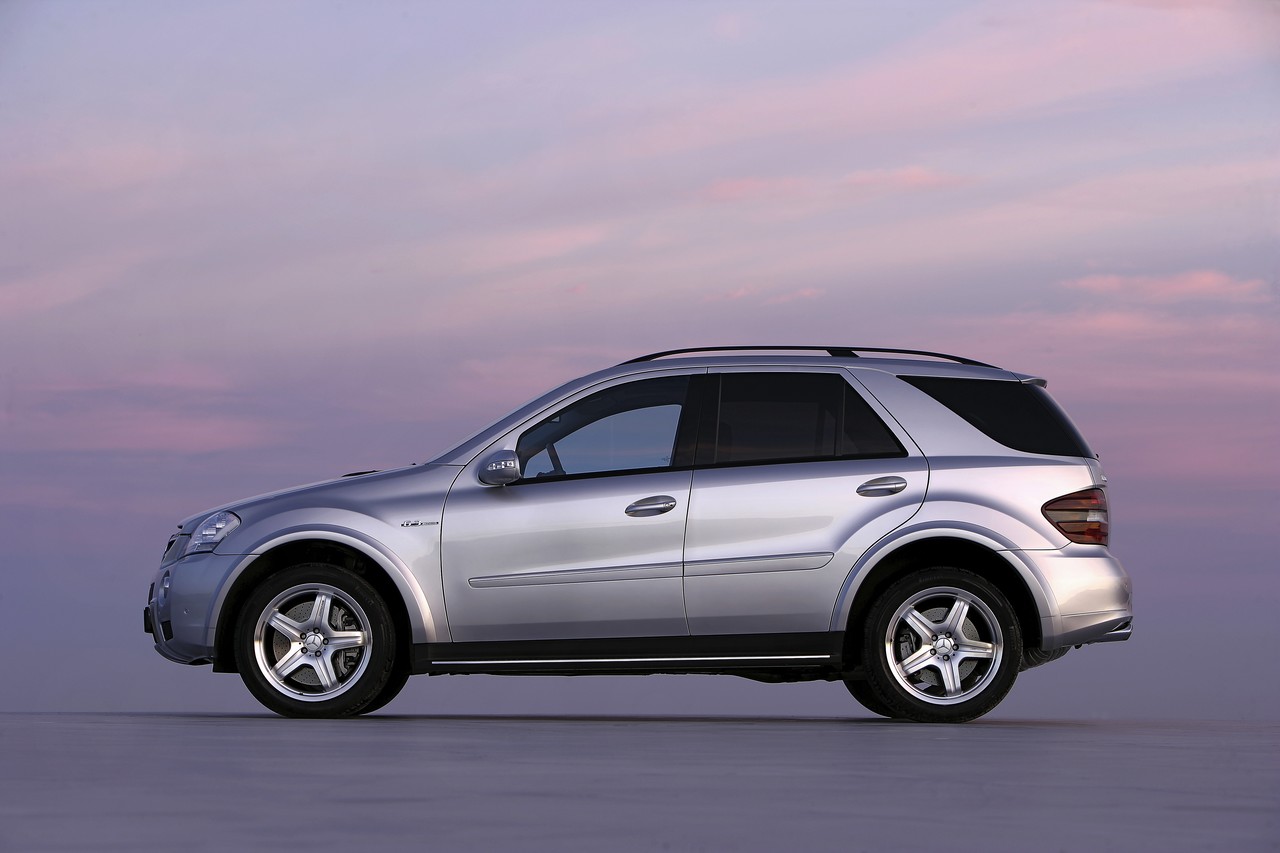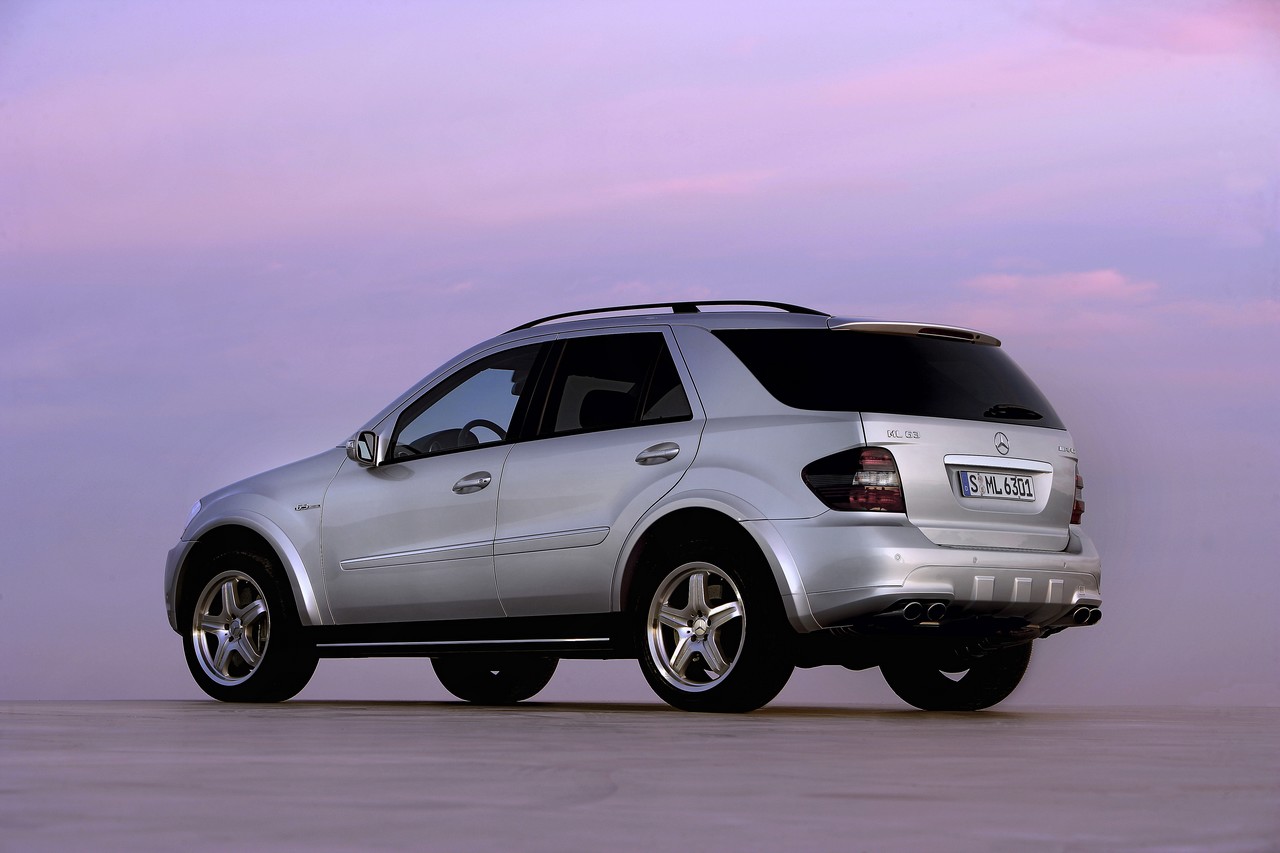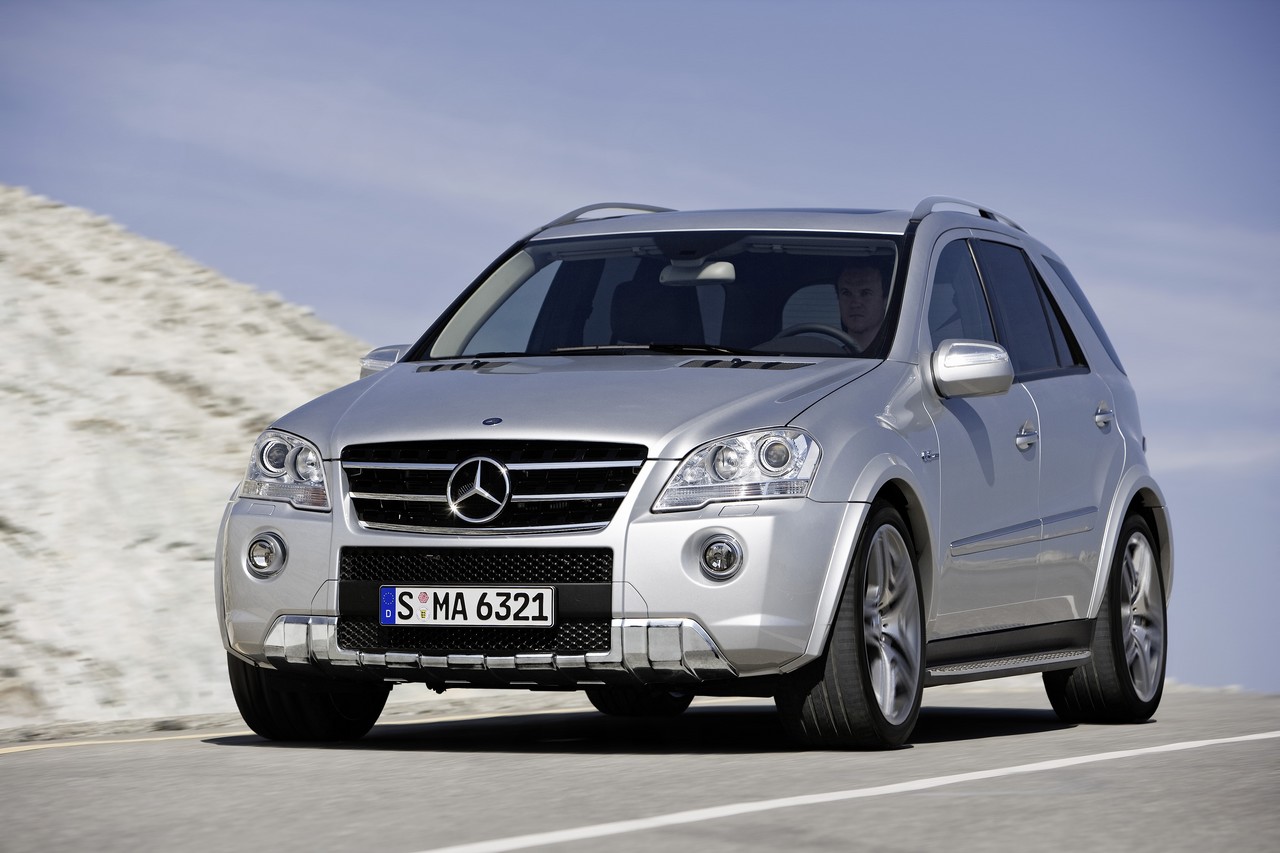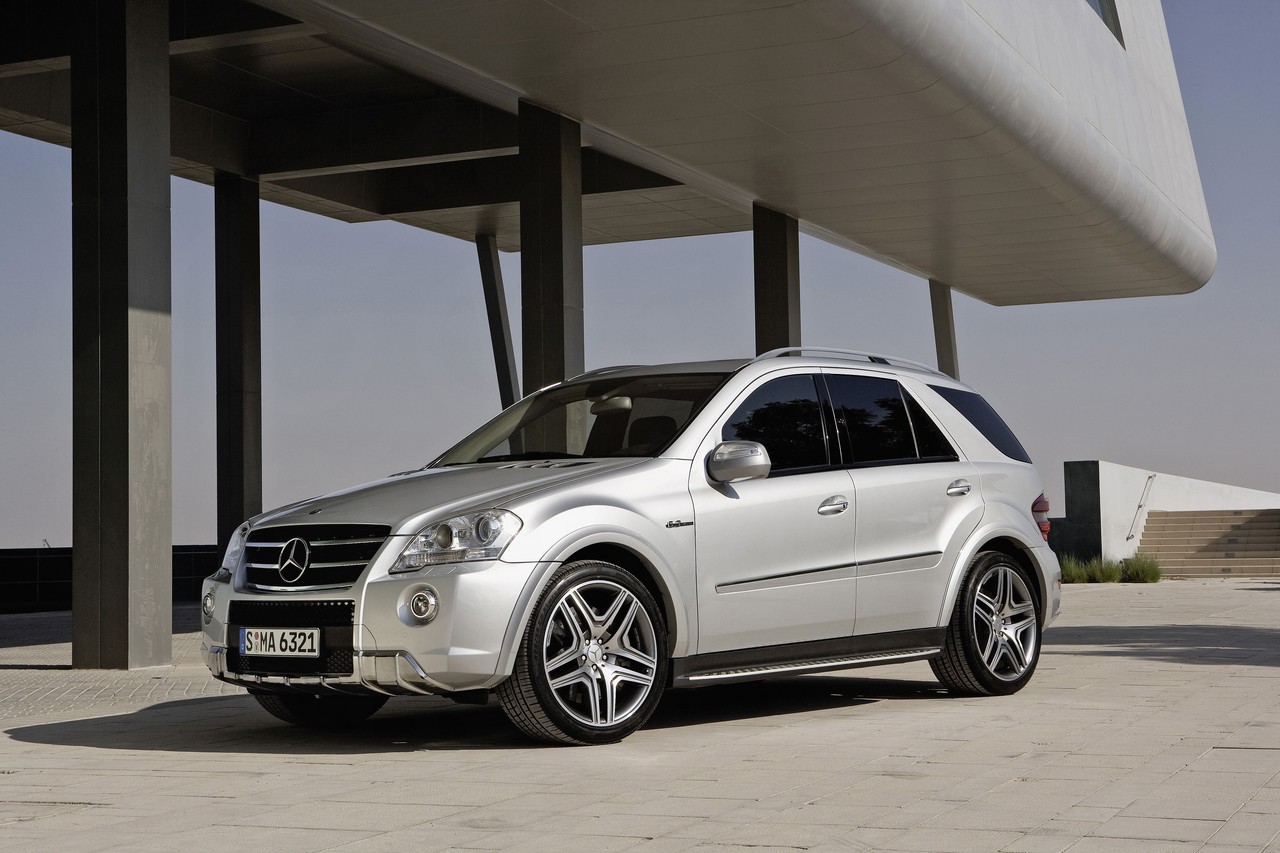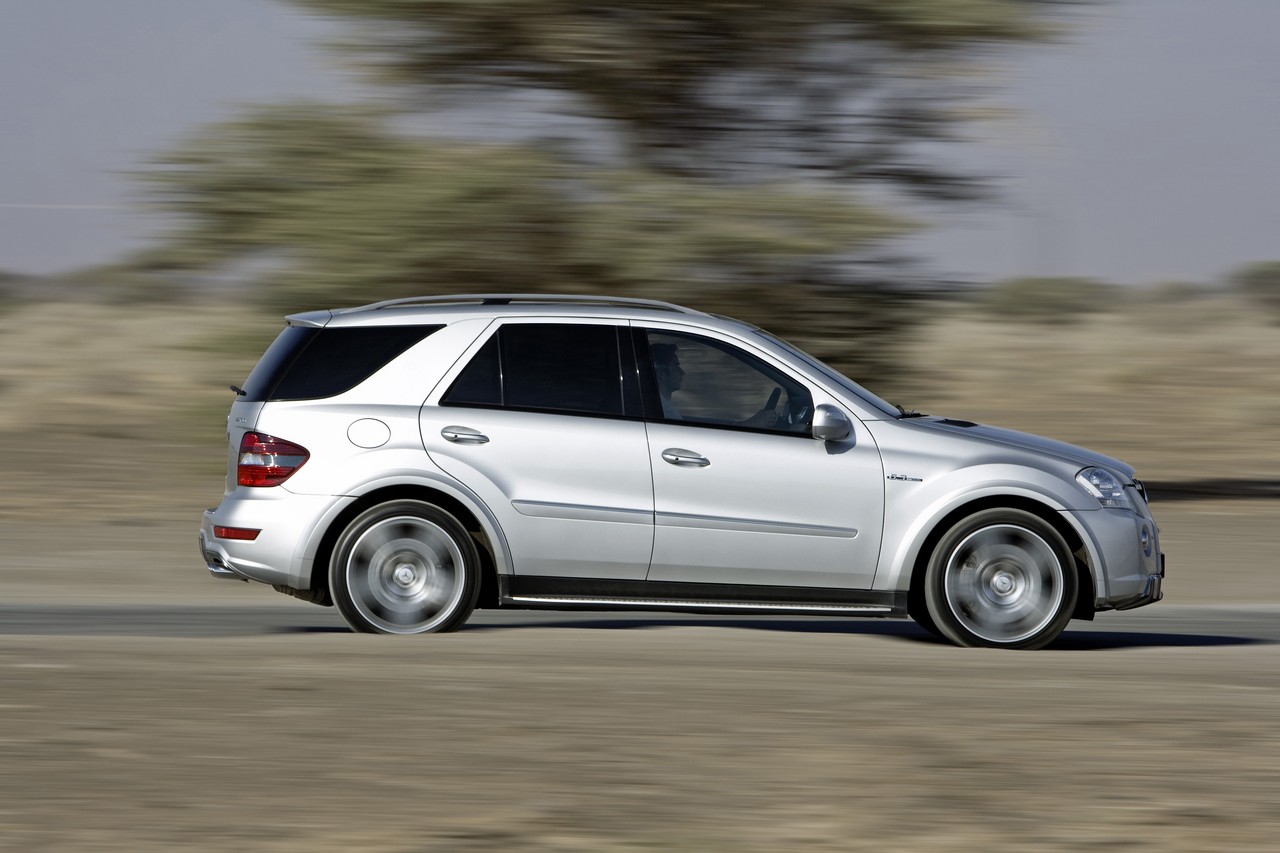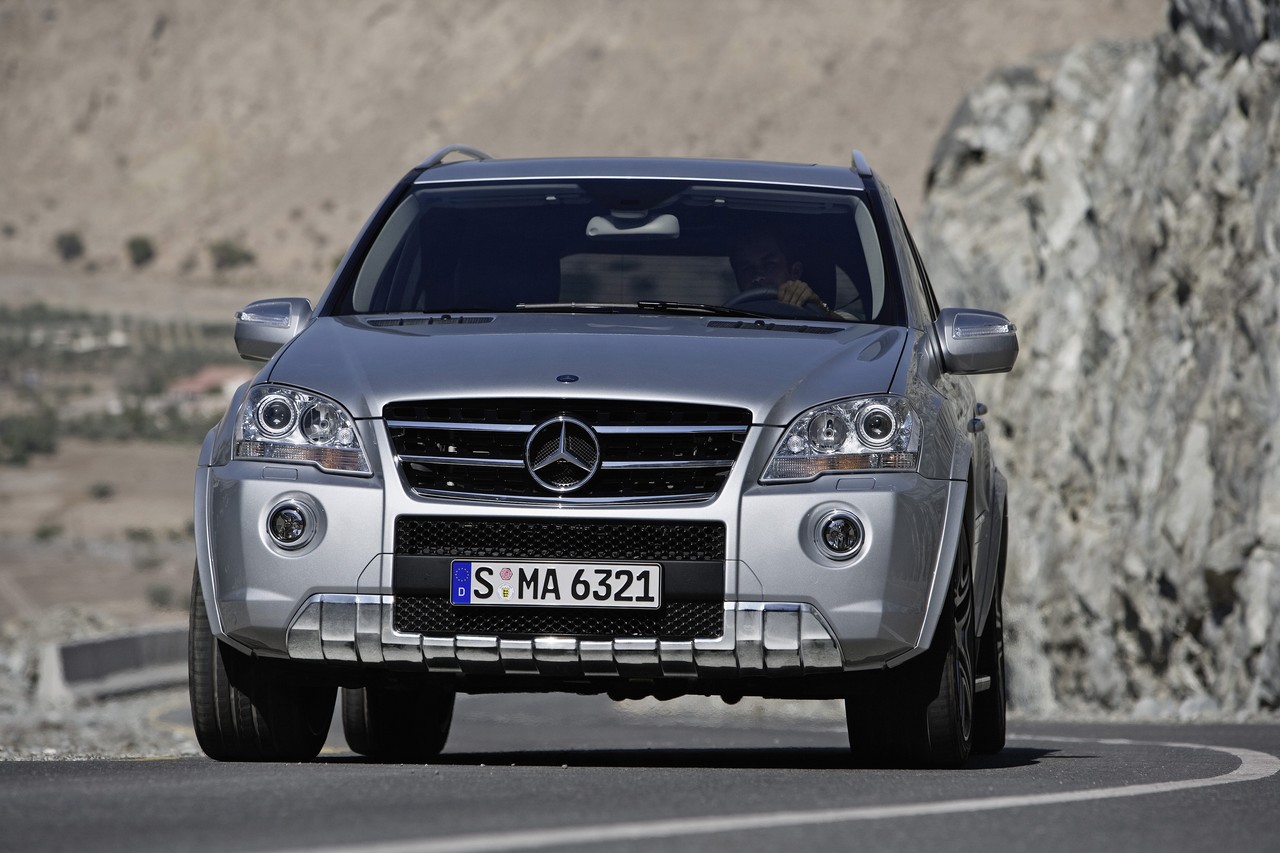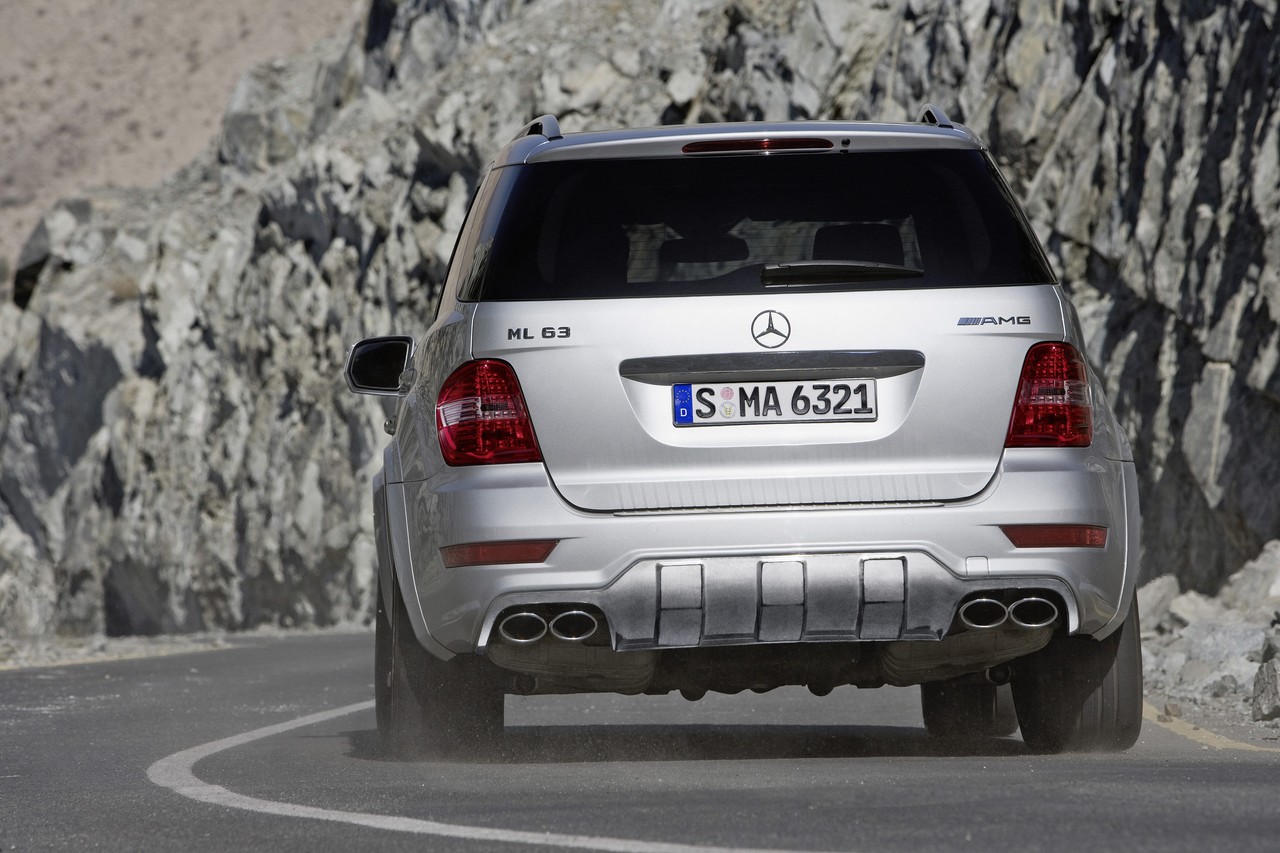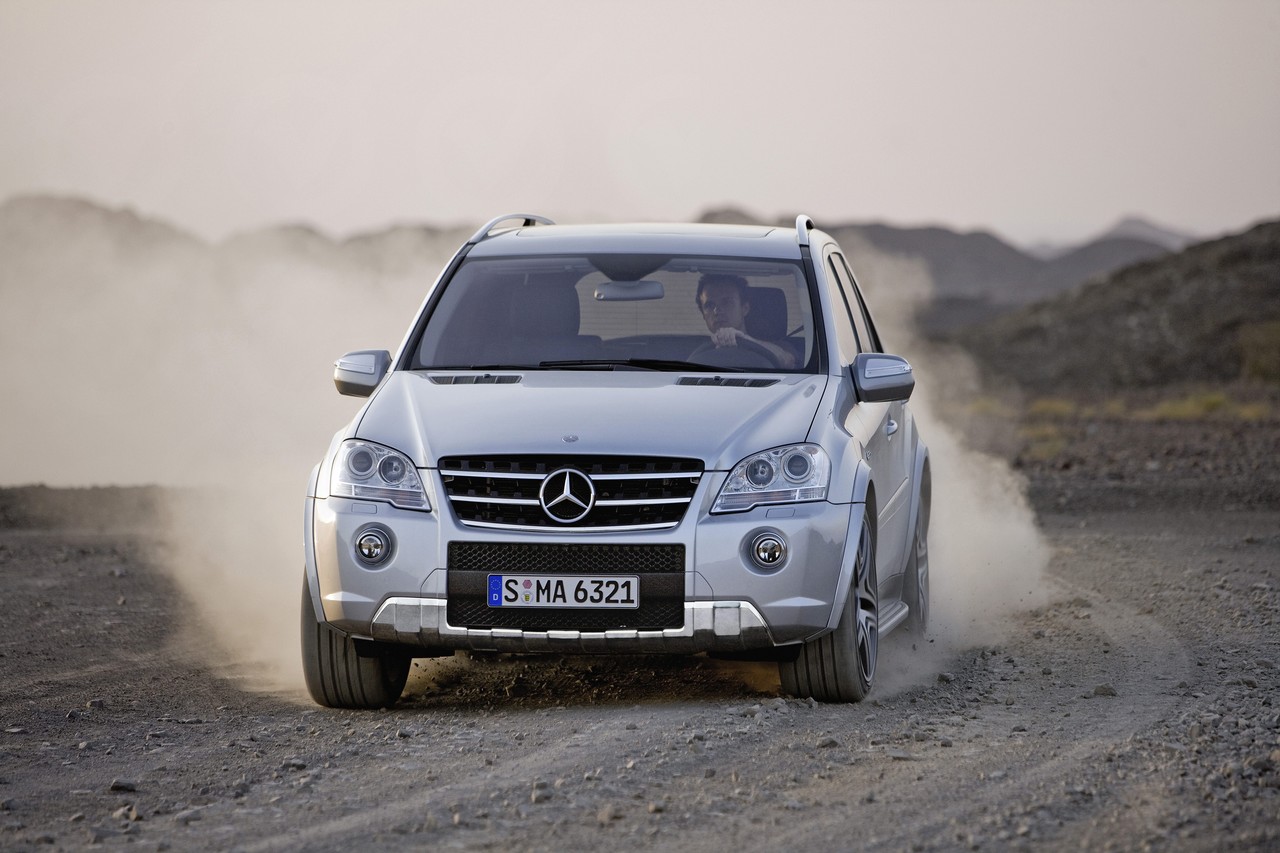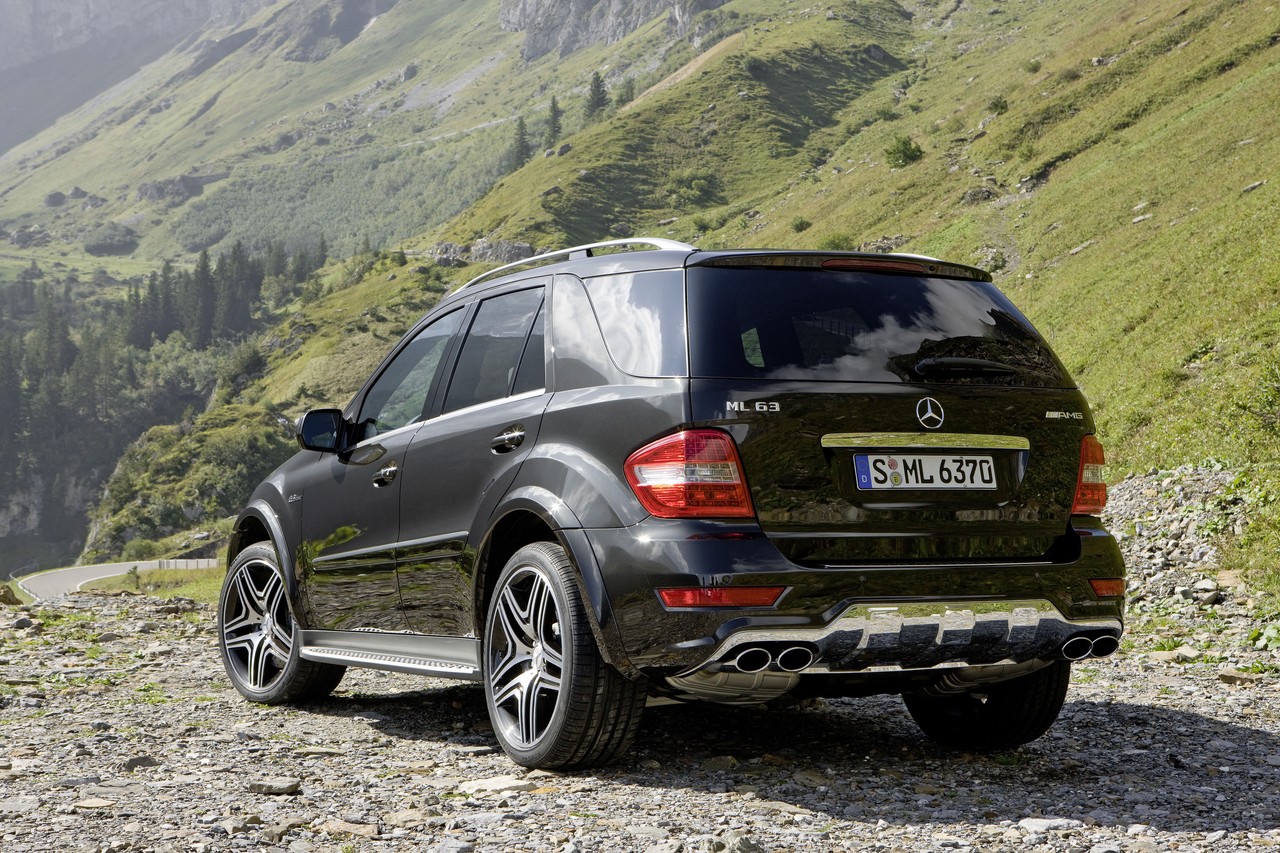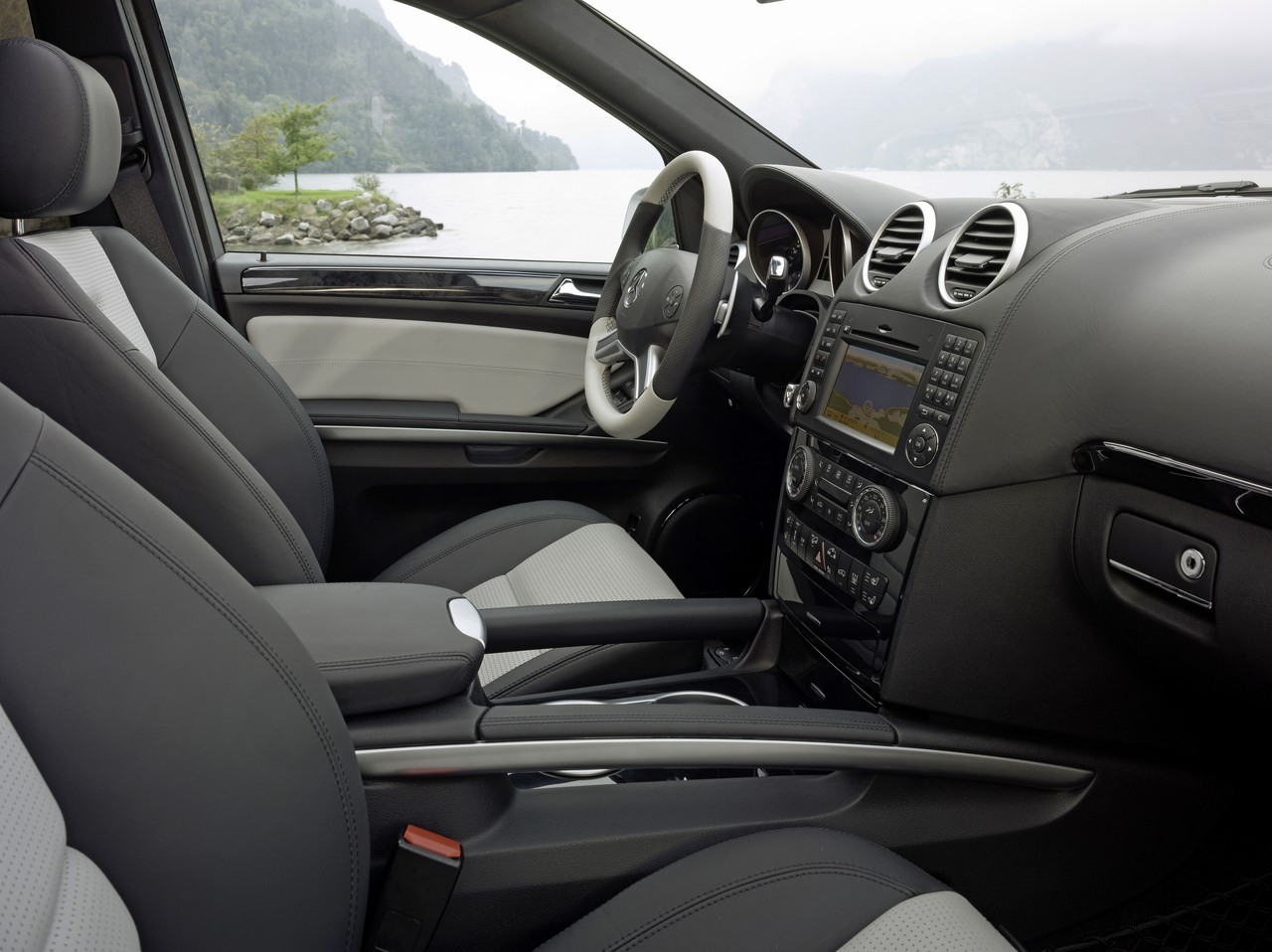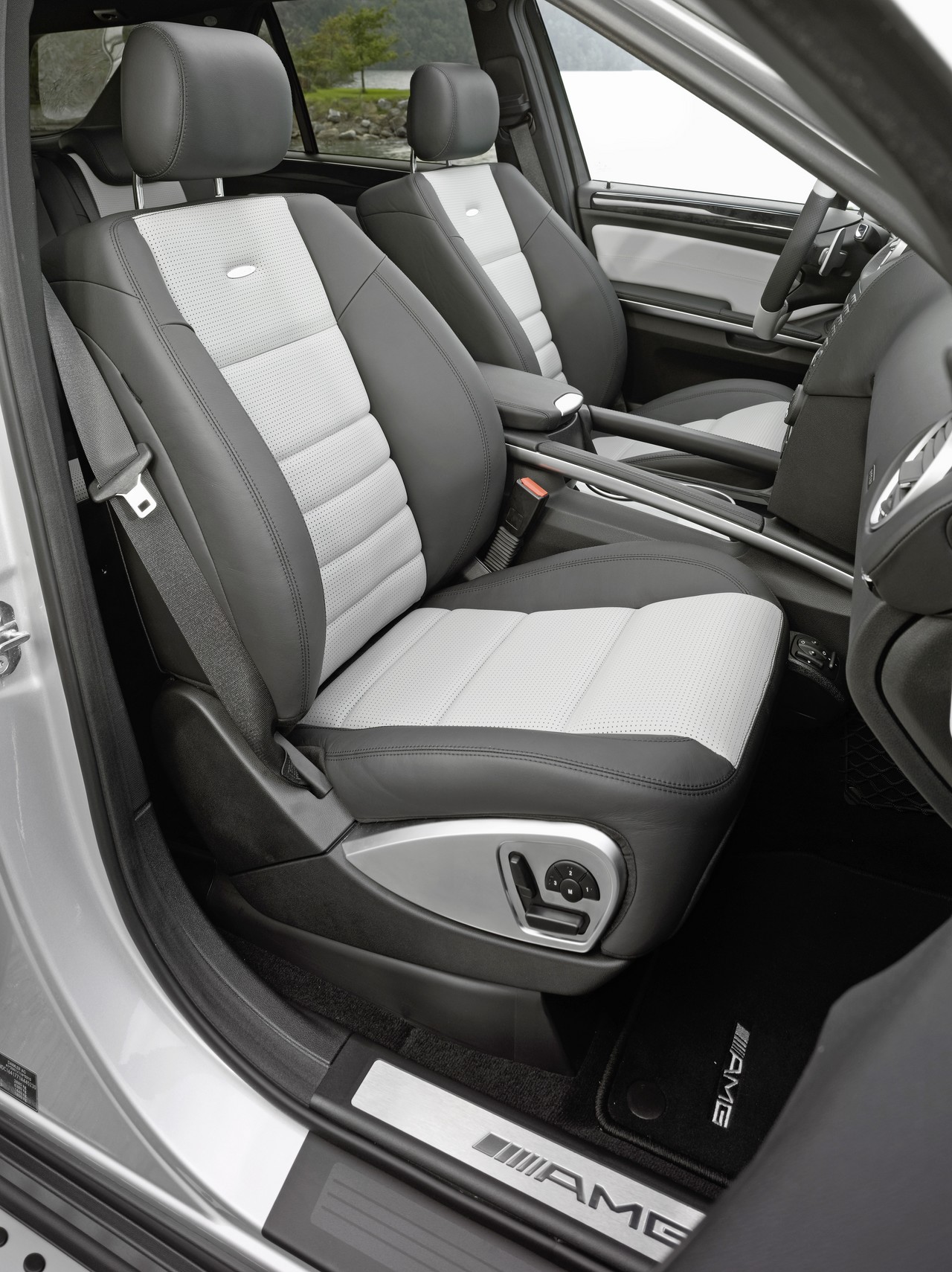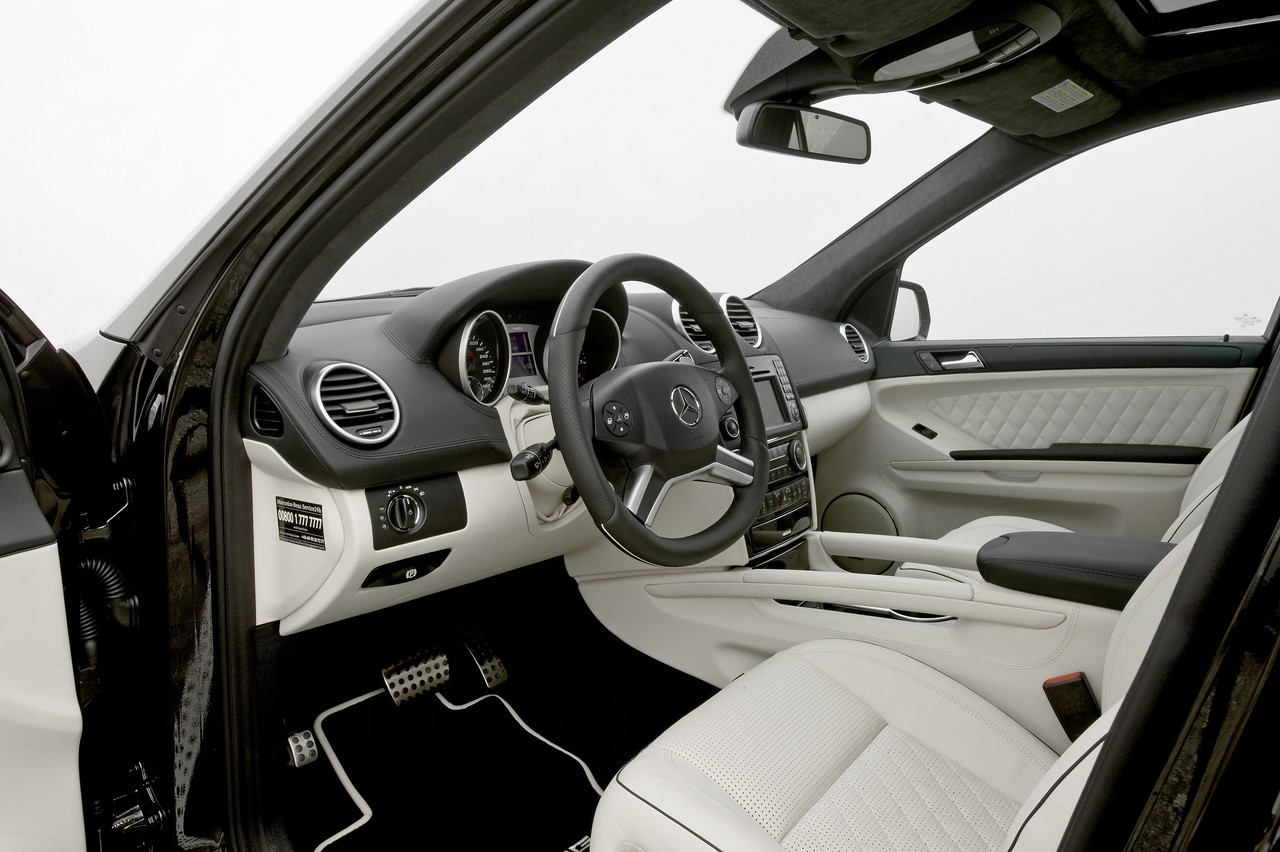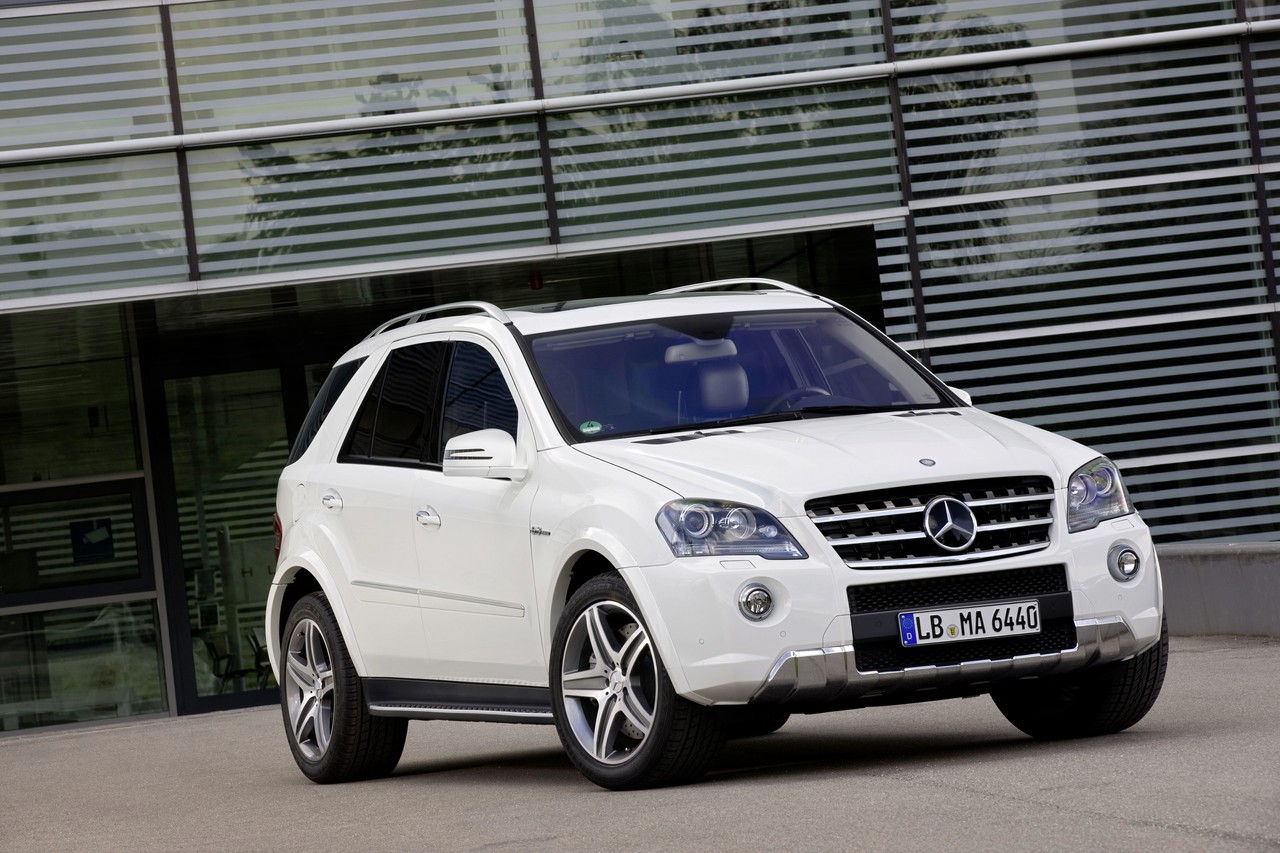
- Powerful 6.2-litre M156 V8 engine
- Impressive dynamics
- Precise, well-weighted steering
- Spacious and comfortable interior
- Firm ride
- Some will find the front seats too narrow
- M156 V8 engine susceptible to cylinder head bolt failure, camshaft lobe and valve lifter wear
- High fuel consumption
Review: Mercedes W164.I ML 63 AMG (2006-08)
Overview
Released in Australia in October 2006, the Mercedes-Benz W164 ML 63 AMG was a four-wheel drive SUV. Manufactured in Tuscaloosa, Alabama, the W164 ML 63 AMG was powered by a 6.2-litre V8 petrol engine that was mated to a seven-speed automatic transmission.
M156.980 V8 engine
Developed and hand-assembled by Mercedes-AMG in Affalterbach, Germany, the 6208 cc M156.982 V8 petrol engine had an aluminium-silicon alloy (AlSi7) block which had 102.2 mm bores and a 94.6 mm stroke, an aluminium-silicon alloy (AlSi17) cylinder head, a Cromax 42CrMo4V forged steel alloy crankshaft, fracture-split forged connecting rods, cylinder bores with twin-wire-arc-sprayed (TWAS) coating, Bosch 9.7 engine management system, double overhead camshafts per cylinder bank (intake cams driven by a double chain from the crankshaft and small gears on the intake cams drive the exhaust camshafts), continuously variable intake and exhaust camshafts (over a range of 40 degrees via electrohydraulic vane-type adjusters), four valves per cylinder (40 mm intake valves and 34 mm exhaust valves) with bucket tappets, a magnesium variable intake manifold (with two integral throttle flaps) and a compression ratio of 11.3:1. Maximum engine speed for the M156 V8 engine was 7200 rpm.
The ML 63 AMG could accelerate from rest to 100 km/h in 5.0 seconds and had an electronically-limited top speed of 250 km/h. Over the combined EUDC cycle, fuel consumption was 16.5 litres per 100 km.
| Engine | Trans. | Peak power | Peak torque | |
|---|---|---|---|---|
| ML 63 | 6.2-litre petrol V8 (M156) | 7sp auto | 375 kW at 6800 rpm | 630 Nm at 5200 rpm |
AMG Speedshift 7G-Tronic transmission
The seven-speed AMG Speedshift 7G-Tronic transmission could be controlled by the ‘Direct Select’ lever mounted by the steering wheel or by gearshift buttons on the steering wheel. From a switch in the centre console, the driver could select from three driving modes:
- Comfort, ‘C’, for softer throttle response, smooth gearshifts and early upshifts to minimise fuel consumption;
- Sport, ‘S’, for greater throttle response, higher engine speeds before upshifting and gearshifts that were around 30 per cent faster than in Comfort; and,
- Manual, ‘M’, for gearshifts via the paddles, maximum throttle response and gearshifts that were 50 per cent faster gearshifts than Comfort.
The transmission also featured an automatic throttle-blipping function during downshifts for almost jolt-free gearshifts and to reduce load-change responses.
The gear ratios for the AMG Speedshift 7G-Tronic were 4.38 (1st), 2.86 (2nd), 1.92 (3rd), 1.37 (4th), 1.00 (5th), 0.82 (6th) and 0.73 (7th), while the final drive ratio was 3.45.
Dimensions and body
Rather than the ladder-type frame of the Mercedes W163 M-Class , the W164 ML 63 AMG had integral body construction. Compared to the W163 ML 55 AMG , the W164 ML 63 AMG was 185 mm longer (at 4820 mm), 68 mm wider (1951 mm), 59 mm taller (1863 mm) and had a 95 mm longer wheelbase (2915 mm); kerb weight increased by 80 kg to 2310 kg. Cargo capacity with the rear seats in position was 551 litres, though this increased to 2050 litres when the rear seats were folded flat.
Suspension
The Mercedes W164 ML 63 AMG had double wishbone front suspension in which the upper wishbone was made of forged aluminium and located in a high position, while the lower wishbone and steering knuckle were made of nodular cast iron. To reduce vibrations, four rubber bearings were used to isolate the front subframe from the vehicle body. Compared to the W163 M-Class, the spring struts had longer travel and more effective rubber bearings for greater ride comfort. The spring struts contained cylindrical coil springs, single-tube gas-pressure shock absorbers and large head bearings; a torsion bar stabiliser was attached to the spring strut by a linkage.
The rear axle was mounted on a subframe that was isolated from the body by two rubber bearings and two hydro-mounts. The W164 M-Class’s four-link suspension consisted of:
- A lower wishbone made from nodular cast iron;
- An upper steering arm that was an assembly of sheet steel camber arms and forged steel rods; and,
- Track rods that were located behind the wheel centres and of welded tubular construction.
The rear axle coil springs and single-tube shock absorbers were positioned in line; a torsion bear stabiliser was also used.
AIRMATIC and Adaptive Damping System (ADS)
The Mercedes ML 63 AMG had a road-going version of Mercedes-Benz’s AIRMATIC air suspension system which could lower the suspension by 15 mm at higher speeds to reduce wind resistance and enabled the driver to select from three settings.
The ML 63 AMG was also fitted with Mercedes-Benz’s ‘Adaptive Damping System’ (ADS) which controlled shock absorber response based on road surface, driving style and wheel loads via electronically-controlled solenoid valves that modified rebound and compression damping. The variable ADS gas-pressure shock absorbers and air springs were integrated into a spring strut at the front axle and, for the rear axle, located behind the air spring. ADS could select from four damping maps:
- Stage 1: soft compression and rebound settings for comfort;
- Stage 2: Skyhook mode for soft rebound setting and a hard compression setting;
- Stage 3: Skyhook mode for soft compression setting and hard rebound setting; and,
- Stage 4: hard rebound and compression settings to reduce wheel load fluctuations when cornering at speed.
When body movements were small, the ML 63 AMG would select Stage 1. If body acceleration values exceeded a threshold, the solenoid valves would continuously switch between stages 2 and 3 to compensate for roll and pitch. The driver could influence the changeover thresholds between the four ADS stages, as well as the spring rate, by pressing a button in the centre console. The driver could also select from Auto, Sport and Comfort modes.
Steering
The Mercedes ML 63 AMG had rack-and-pinion steering with speed-sensitive power assistance.
4ETS four-wheel drive system
The Mercedes W164 M-Class had a permanent four-wheel drive system with open differentials. The transfer case was directly flanged to the 7G-Tronic transmission and used propeller shafts to distribute power to the front and rear axles with a 40:60 front:rear torque split; a bevel differential was used to compensate for differences in the rotational speed between the axles.
Mercedes-Benz’s ‘4ETS’ electronic traction system controlled the torque distribution between the wheels. If a wheel lost traction, 4ETS would apply brief braking pulses to transfer torque from that wheel to the wheels with traction.
For the W164 ML 63 AMG, the four-wheel drive system gained the following functions:
- Off-road ABS: active at speeds below 30 km/h, Off-Road ABS was designed for poor surfaces or steep downhill gradients. At regular intervals, the front wheels would be automatically braked with sufficient force that they would lock up – this would cause the vehicle to dig into the loose surface and come to a halt more easily. As a result, braking distances could be significantly reduced;
- Downhill Speed Regulation (DSR): designed for steep downhill gradients and activated by pushing a button in the centre console. With DSR, vehicle speed would be kept constant by engine and transmission control, and automatic braking. While the system would initially set a speed of 6 km/h, the driver could use the cruise control stalk to set the desired downhill speed between 4 km/h (minimum) and 18 km/h (maximum); and,
- Start-Off Assist: helped the vehicle more safely accelerate from rest when on steep uphill gradients, by preventing the vehicle from rolling bac kWards as the driver moved their foot from the brake pedal to the accelerator. During this period, brake pressure would be provided by an ‘actively controllable’ brake servo unit. Start-Off Assist was automatically activated by an inclination sensor.
Safety equipment
Standard safety equipment for the Mercedes W164 ML 63 AMG included dual front airbags, front and rear side airbags, full-length curtain airbags, ABS, electronic brake force distribution, brake assist, electronic stability control, traction control, active front seat head restraints (‘Neck-Pro’) and pre-tensioners and load limiters for all seats.
The W164 M-Class was also fitted with Mercedes-Benz’s ‘Pre-Safe’ system, which anticipated and prepared for collisions by tensioning the seatbelts, adjusting the seat positions for optimal airbag deployment and closing the sunroof (if open).
Brakes: ML 63 AMG
The Mercedes ML 63 AMG had 350 mm by 32 mm front brake discs and 330 mm by 22 mm rear discs; both front and rear discs were internally vented.
Features: Mercedes ML 63 AMG
Standard features for the Mercedes ML 63 AMG included 19-inch five-spoke AMG alloy wheels (9.5J) with 295/45 R19 tyres, a twelve speaker sound system with a six-disc CD player, Mercedes-Benz’s COMAND APS (Cockpit Management and Data Auto Pilot System) with satellite navigation, four-zone climate control air conditioning (‘Thermotronic’), AMG multicontour front seats with nappa leather trim and Alcantara shoulder panels, power adjustable and heated front seats, cruise control, directional bi-xenon headlights with washers, front and rear fog lights, rear vision camera, front and rear parking sensors, automatic headlights, rain-sensing wipers, 60/40 split and folding rear seats, AMG leather steering wheel with gearshift buttons, remote central locking, power adjustable mirrors with heating and folding functions, power windows, a power adjustable steering column (for height and reach), electrochromatic interior and door mirrors, front seat memory settings, power sunroof, ambient lighting, a compass, AMG door sills, stainless steel pedals with rubber studs, cargo net and cover, trip computer, tyre pressure monitoring, a motion-sensing alarm and an immobiliser.
Brochure
Specifications
Review: Mercedes W164.II ML 63 AMG (2008-11)
Overview
Released in Australia in October 2008, the Mercedes-Benz W164 Series II (W164.II) ML 63 AMG could be identified by its larger AMG radiator grille and new aprons with chromed underguards.
| Engine | Trans. | Peak power | Peak torque | |
|---|---|---|---|---|
| ML 63 AMG | 6.2-litre petrol V8 (M156) | 7sp auto | 375 kW at 6800 rpm | 630 Nm at 5200 rpm |
Safety equipment
Compared to its W164.I predecessor, standard safety equipment for the Mercedes W164.II ML 63 AMG was improved with the introduction of a driver’s knee airbag.
Euro NCAP crash testing
In Euro NCAP crash testing , a Mercedes-Benz W164.II ML 320 CDI received a five star adult occupant protection rating with a score of 33.97 out of 37. In the frontal offset impact test, there was a slight risk of serious chest injury and leg injury for front occupants. Maximum points, however, were awarded in the side and pole impact tests.
Features: Mercedes ML 63 AMG
Standard features for the Mercedes W164.II ML 63 MG were extended to include 20-inch five-spoke AMG wheels with 295/40 R20 tyres, Mercedes-Benz’s NTG 2.5 COMAND APS with a 6.5-inch colour monitor, DVD-based navigation, a six-disc CD/DVD changer, MP3/WMA/AAC compatibility, a UCI media interface for auxiliary inputs (3.5 mm/USB/SD card), Bluetooth mobile phone connectivity, 4 GB hard drive for music storage, voice recognition (‘Linguatronic’), a TV tuner (digital and analogue) and Nappa leather trim for the upper dashboard.
June 2010 update
In June 2010, the Mercedes ML 63 AMG underwent a minor styling update which included a new bonnet with power domes, darkened bi-xenon headlights, darkened tail lamps with a clear-lens design and LED technology.
Related links
